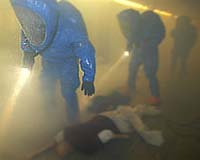| . |  |
. |
Arlington, Va. (UPI) Jun 8, 2009 The recent outbreaks of swine flu arrived on American shores without warning. Fortunately, this biohazard proved less threatening than first thought. But what would have happened if this had been an extremely virulent form of influenza as happened in 1918? Or if the catastrophe was a biological weapon deployed by a terrorist? Without accurate and timely warning, an effective response is virtually impossible. The U.S. Department of Homeland Security has been inexplicably slow in deploying new sensor systems to provide improved warning of attack, whether by biological threats or nuclear materials being smuggled through U.S. ports of entry. In the aftermath of the 2001 anthrax letter attacks, special anthrax sensors were deployed in U.S. Postal Service mail handling centers. A limited number of other biosensors -- the exact number and their location is classified -- were deployed at selected high-traffic locations in major metropolitan areas. Yet, more than eight years later, no more biosensors have been deployed. As the U.S. Postal Service learned how to employ their anthrax sensors, it discovered it could make do with fewer than the Department of Homeland Security had initially deployed. The excess inventory, several hundred units, was returned to the Department of Homeland Security. Rather than deploying these effective systems to provide some level of coverage for critical targets such as federal buildings in Washington, the Department of Homeland Security has allowed them to sit in a warehouse. A new generation of sensors has been developed under contract to the Department of Homeland Security that could provide reliable warning of a biological threat in a matter of hours. The Autonomous Pathogen Detection System is essentially an automated laboratory in a box, able to detect multiple threats, and report every four hours. This system has already undergone two years of field testing. The problem is the same when it comes to the detection of nuclear threats. The Department of Homeland Security's Domestic Nuclear Detection Office has successfully developed and tested advanced radiation detectors much more capable than the existing ones. Yet the Department of Homeland Security dithers while promising to deploy even better sensors sometime in the future. The state of Florida is deploying one of these radiation detectors, so why can't the Department of Homeland Security? The Department of Homeland Security needs to take a page from Secretary of Defense Robert Gates' playbook and deploy the 70 percent solution now rather than waiting for the 99 percent solution years in the future. First, the Department of Homeland Security should deploy its inventory of excess anthrax sensors to key transit terminals and points of entry. Next it should accelerate production of the new generation of biosensors with the intent of widespread deployment beginning in 2010. Finally, the Department of Homeland Security needs to deploy improved nuclear detection sensors at the nation's ports of entry. Without rapid and reliable warning, the United States faces the prospect of being faced with a biological or nuclear catastrophe before it is even aware that it is under attack. (Loren B. Thompson is chief operating officer of the Lexington Institute, an Arlington, Va.-based think tank that supports democracy and the free market.) Share This Article With Planet Earth
Related Links The Long War - Doctrine and Application
 LockMart Provide Enhanced Biological Aerosol Warning Systems For Japan
LockMart Provide Enhanced Biological Aerosol Warning Systems For JapanBaltimore MD (SPX) Jun 08, 2009 The Japan Ground Self Defense Force recently exercised an option on an existing contract with Lockheed Martin and its trading partner Itochu, of Tokyo, for the delivery of additional Enhanced Biological Aerosol Warning Systems (EBAWS). Lockheed Martin's EBAWS will be used by the Chemical, Biological, Radiological and Nuclear (CBRN) Defense Units of the Japan Ground Self Defense Forces to ... read more |
|
| The content herein, unless otherwise known to be public domain, are Copyright 1995-2009 - SpaceDaily. AFP and UPI Wire Stories are copyright Agence France-Presse and United Press International. ESA Portal Reports are copyright European Space Agency. All NASA sourced material is public domain. Additional copyrights may apply in whole or part to other bona fide parties. Advertising does not imply endorsement,agreement or approval of any opinions, statements or information provided by SpaceDaily on any Web page published or hosted by SpaceDaily. Privacy Statement |